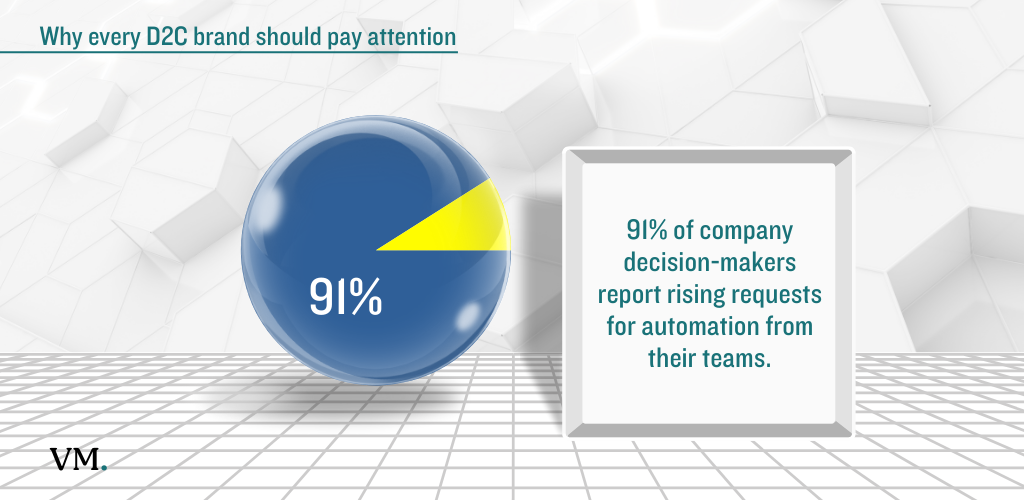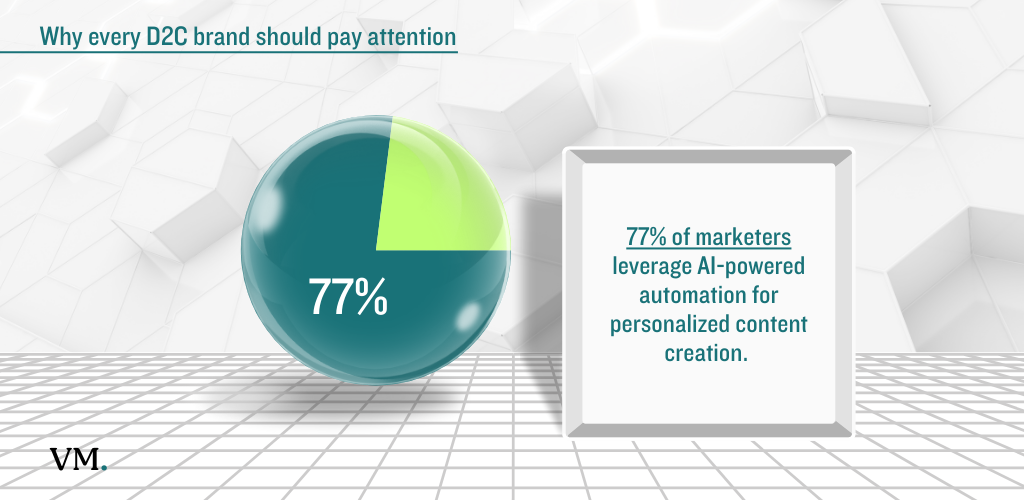More and more D2C brands are using automation. At this point, it’s not about jumping the bandwagon; it’s about surviving. If you’re running—or thinking about starting—a direct-to-consumer (D2C) brand, you’ve probably heard a lot about automation. But what does that really mean for your business, your team, and your customers? In 2025, automation isn’t about replacing people; it’s about making everything run smoother so you can focus on what matters most: building a brand people love.
What Automation Really Looks Like When Smart D2C Brands Are Using Automation
Let’s be honest: automation isn’t just for tech giants. Small and mid-sized D2C brands are using tools and smart setups to handle the repetitive stuff, freeing up time for creativity and customer connection.
1. Handling Orders and Inventory Without the Headaches
Remember the days when a sudden rush of orders meant scrambling to update spreadsheets and risking mistakes? Modern D2C brands use systems that automatically track inventory, update stock levels, and even alert you when it’s time to reorder. This means fewer oversells, happier customers, and less stress for your team.
2. Personalizing the Customer Experience—Effortlessly
Your customers want to feel special. Automation lets you send tailored emails, recommend products based on past purchases, and remind shoppers when their favorite items are back in stock—all without lifting a finger. The result? More sales, fewer abandoned carts, and customers who feel like you really get them.
3. Customer Support That’s Always On
Nobody likes waiting for answers. Simple chatbots and automated messaging can handle common questions about shipping, returns, and order status, so your team can focus on the trickier issues that need a human touch. This means faster responses and happier shoppers—even at midnight.
4. Keeping the Brand Experience Consistent Everywhere
Customers interact with your brand on your website, social media, email, and maybe even in a pop-up shop. Automation tools help you keep your messaging and promotions consistent across all these channels, so your brand feels cohesive no matter where your customers find you.
D2C by the Numbers—Growth, Impact, and the Consumer Shift
Direct-to-consumer (D2C) brands have transformed from niche disruptors into major players, reshaping the global retail landscape. The numbers tell a compelling story of explosive growth, shifting consumer preferences, and the rapid adoption of new technologies.
The Automation Imperative: Why Every D2C Brand Should Take Note
-
-
91% of company decision-makers report rising requests for automation from their teams. This surge reflects the growing need to streamline operations, reduce costs, and improve customer experiences as expectations and competition rise.
-
Organizations see a $5.44 return for every dollar spent on marketing automation. That’s a powerful incentive for D2C brands—especially those facing rising customer acquisition costs and shrinking margins.
-
Nearly 40% of marketers now have mostly or fully automated customer journeys. This means that a significant portion of customer interactions—from initial contact to post-purchase follow-ups—are managed by automated systems, freeing up teams for higher-value work.
-

Automation in Key D2C Functions: Where It Makes a Difference
-
Marketing and Customer Engagement
-
77% of marketers leverage AI-powered automation for personalized content creation. This enables D2C brands to deliver tailored messages, product recommendations, and offers at scale, increasing engagement and conversion rates.
-
Email and SMS marketing drive 30–40% of repeat sales for D2C brands. Automated reminders, cart recovery, and post-purchase follow-ups are especially effective at keeping customers coming back.
Operations and Fulfillment
-
Automated inventory management and logistics can reduce fulfillment errors and costs by up to 30%. Brands that invest in these technologies see fewer mistakes, faster shipping, and happier customers.
-
Data-driven supply chain optimization helps D2C brands achieve significant cost savings. Real-world case studies show that automation and analytics can streamline everything from order processing to returns, making operations leaner and more efficient.
Customer Support
-
Automated chatbots and support tools handle up to 40% of customer queries. These systems provide instant answers to common questions, reducing wait times and freeing up human agents for more complex issues.
-
Automated support is available 24/7, matching the always-on expectations of today’s shoppers. This is especially important for D2C brands serving global or digital-native audiences
-

The Rise of Social Commerce and Digital Discovery
-
Social commerce is projected to generate over $100 billion in revenue in 2025. Platforms like TikTok, Instagram, and Facebook are becoming primary discovery and purchase channels for younger consumers.
-
40% of Gen Z shoppers discover brands via social media. Influencer-led campaigns and live shopping events are driving engagement and conversions among this key demographic.
-
Buy Now, Pay Later (BNPL) options and flexible payment methods are boosting conversion rates for D2C brands. These innovations make products more accessible and encourage repeat purchases.
Operational and Technological Trends
-
AI and predictive analytics are revolutionizing D2C operations. From smart warehouses and automated customer service to personalized marketing, technology is enabling brands to deliver faster, smarter, and more relevant experiences.
-
Advanced fulfillment solutions—including automation, robotics, and micro-fulfillment centers—are becoming standard. These innovations help D2C brands meet rising expectations for speed and convenience.
-
Omnichannel strategies are now essential. Successful D2C brands are expanding beyond pure online play into pop-ups, retail partnerships, and even flagship stores—all while maintaining a seamless customer experience.
Looking Ahead
The data is clear: D2C is not just a trend, but a fundamental shift in how brands connect with consumers. With sales surging, consumer preferences evolving, and technology advancing at a rapid pace, D2C brands that embrace innovation, authenticity, and direct engagement are poised to lead the future of retail.
Real-World Impact: More Time, Less Stress, Happier Customers
- You’ll spend less time on repetitive tasks and more time on creative projects, product development, or simply connecting with your community.
- Fewer mistakes mean fewer refunds, returns, and frustrated customers.
- Your team can focus on building relationships and delivering exceptional service, instead of getting bogged down in admin.
The Broader Impact: Efficiency, Profitability, and Growth
-
Automation helps D2C brands scale without proportionally increasing headcount. This is crucial as brands expand into new markets or launch new product lines36.
-
By reducing manual errors and optimizing processes, automation boosts both productivity and customer satisfaction. Teams spend less time on repetitive tasks and more time building relationships and innovating36.
-
The marketing automation market is projected to reach $15.62 billion by 2030, growing at 15.3% annually. This rapid growth underscores the central role automation will play in the future of D2C and e-commerce
The Bottom Line: Automation Is Your Ally, Not Your Overlord
In 2025, automation isn’t about being flashy or futuristic. It’s about making your D2C brand more efficient, reliable, and customer-focused. By automating the right tasks, you’ll free up time and energy to do what really matters: creating products people love and building a community around your brand.
So, what will you automate first?
Start small—maybe with inventory alerts or automated shipping notifications—and watch your business (and your sanity) benefit. Automation isn’t the future; it’s the smart way to run your D2C brand right now.
FAQ
What exactly is automation in D2C?
Automation in D2C means using software and technology to handle routine tasks—like sending emails, managing inventory, or answering customer questions—so you and your team can focus on bigger, more creative work.
Why should my D2C brand care about automation?
Automation helps you save time, reduce mistakes, and keep up with customer expectations for fast, personalized service. It also lets you scale your business without constantly adding more staff.
What are some common tasks that can be automated?
You can automate order confirmations, shipping notifications, inventory updates, marketing emails, basic customer support, and even social media posts.
Will automation make my brand feel less personal?
Not if you do it right! The best D2C brands use automation for routine tasks but keep their brand voice friendly and authentic. They also make sure real people are available for important conversations.
How does automation help with customer service?
Automation tools like chatbots can answer common questions instantly, 24/7. This means customers get quick help, and your team can focus on more complex issues that need a human touch.
What’s the ROI of automation for D2C brands?
Many brands see a strong return—up to $5 back for every $1 spent on marketing automation, for example. Automation also cuts down on errors and wasted time, which can save money and boost profits.
Can small D2C brands afford automation?
Absolutely! There are affordable tools and platforms designed for small businesses. Many offer free trials or low-cost plans, so you can start small and grow as your business does.
How do I get started with automation?
Start by identifying repetitive tasks that take up a lot of time, like sending order confirmations or tracking inventory. Then, look for user-friendly tools—like Shopify, Klaviyo, or Zendesk—that can help you automate those tasks.
What’s the biggest mistake to avoid with automation?
Don’t automate just for the sake of it. Make sure every automated process improves your customers’ experience or makes your team’s life easier. And always keep your brand’s personality front and center.
Will automation replace my team?
No. Automation handles the boring, repetitive stuff so your team can focus on building relationships, creating great products, and growing your brand.



